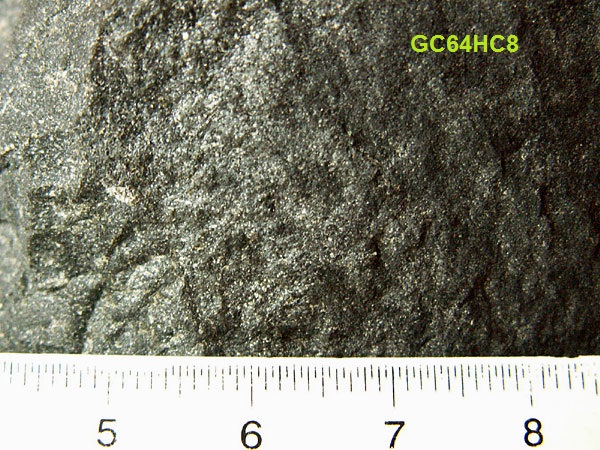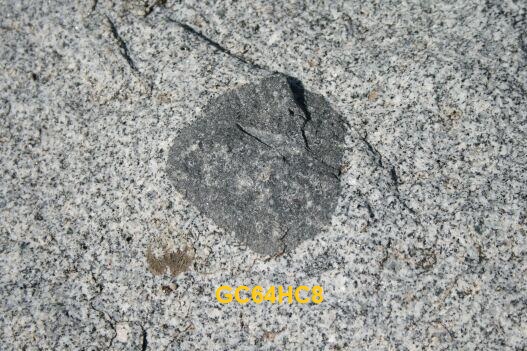|
Phaneritic texture
|
Aphanite texture
|
 |
 |
One special type of crystallization rate is the xenolith. Magma may melt part of rocks that find on its ways. They can be enclosed totally or partially during the cooling process. They can be recognized as different colour spots. Also, as they have different composition, the type of crystallization is different.

Xenolith
QUESTIONS:
To log this earthcache, please send the answers to our email. PLEASE do not publish the answers in your log.
- At the coordinates you can find a very famous monument. Please, check the second level of the pedestal (ground level is really dirty). Bearing in mind the rate of the crystallization...Which texture is it? Why?
- Surround the pedestal (at the second level) and look for xenoliths. Check only the ones with more than five centimeters diameter. How many can you find? Which texture? Is it different to the rest of the pedestal? Why?
A photo at the coordinates will be welcome but with no xenoliths in it.
ENGLISH VERSION ABOVE
Las rocas ígneas se forman cuando el magma (roca fundida) se enfría y se solidifica. Si el enfriamiento se produce bajo la superficie terrestre, en unas condiciones estables y de forma lenta, se forman rocas con grandes cristales, denominadas plutónicas o intrusivas. En el caso de que el enfriamiento se produzca sobre la superficie, este proceso será mucho más rápido. Es el caso de una erupción volcánica, tras la cual se forman rocas con cristales invisibles conocidas como volcánicas o extrusivas.
Un caso peculiar es el de las rocas filolianas, que se forman en grietas.
La mayor parte de las rocas ígneas que se han descrito se han formado bajo la superficie de la corteza terrestre. Algunos ejemplos de rocas ígneas son: la diorita, la riolita, el pórfido, el gabro, el basalto y el granito.

La textura de una roca hace referencia al tamaño de sus cristales, disposición y grado de cristalización. Una de las posibles formas de clasificación de las rocas ígneas es por el tamaño de sus cristales:
|
Textura fanerítica
|
Textura anafítica
|
 |
 |
Otro caso particular de cristalización es el de los gabarros (o xenolitos). Éstos son procesos en los que el magma funde porciones de rocas encajantes, quedando englobadas dentro de él, total o parcialmente, durante el proceso de enfriamiento. A simple vista, los reconoceremos como manchas de distinto tono en la roca. Dada su diferente composición, veremos una cristalización distinta en ellos.

Xenolito
PREGUNTAS:
Para poder registrar este earthcache como encontrado, envíanos las respuestas a nuestro correo electrónico. POR FAVOR, no publiques las respuestas en tu registro.
- En las coordenadas facilitadas, puedes encontrar un famoso monumento. Por favor, observa sólo el segundo nivel del pedestal (el nivel del suelo está muy sucio y puede llevar a confusión). Teniendo en cuenta el grado de cristalización de la roca… ¿qué tipo de textura presenta? ¿por qué motivo crees de ese tipo?
- Rodea el monumento (de nuevo sólo fíjate en el segundo nivel) y busca xenolitos en él, pero fíjate únicamente en los que tienen más de cinco centímetros de diámetro. ¿Cuántos puedes observar? ¿Qué tipo de textura tienen? Si hay diferencia en la textura de los xenolitos y del resto de la base del monumento… ¿a qué crees que se debe?
Se agradecerá una foto en las coordenadas, pero de tal forma que no se vea ningún xenolito.